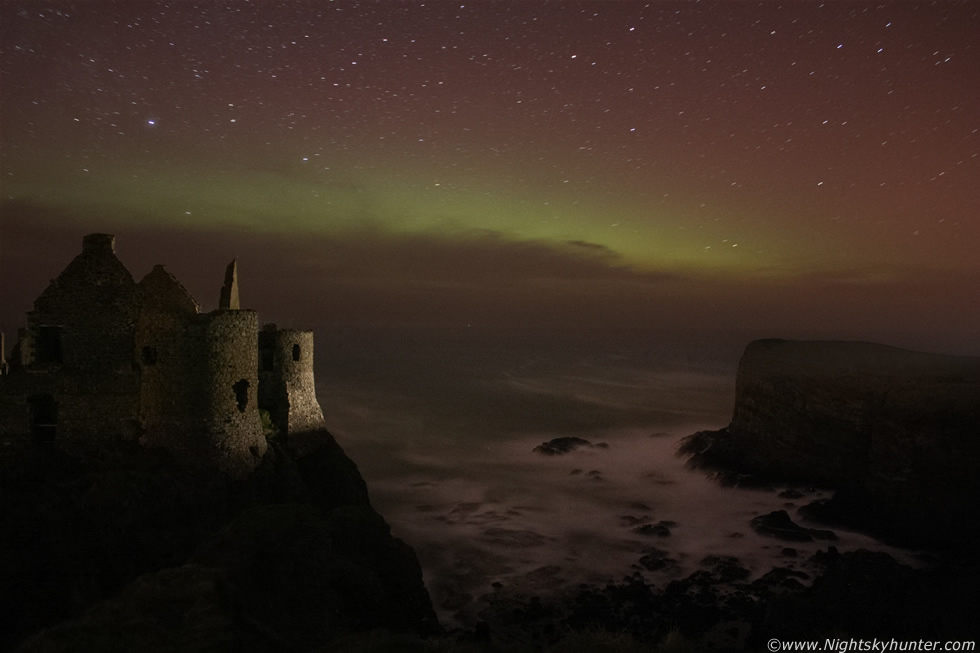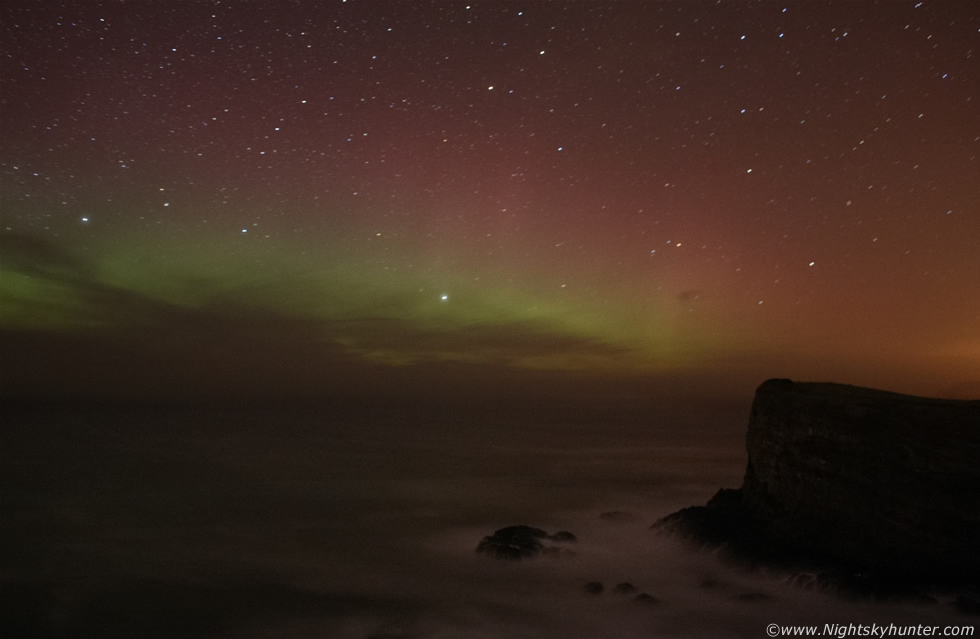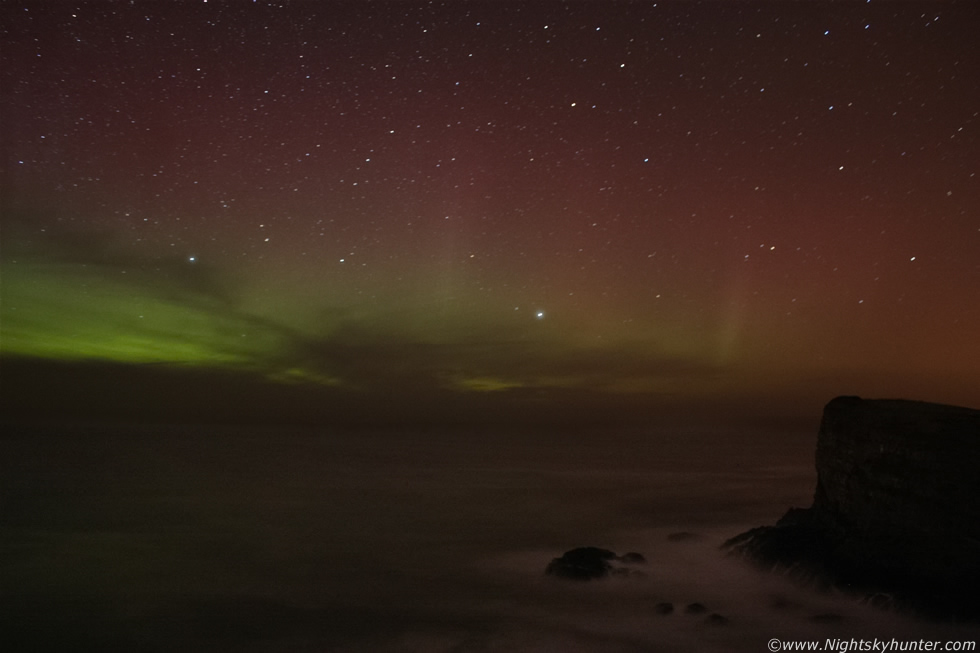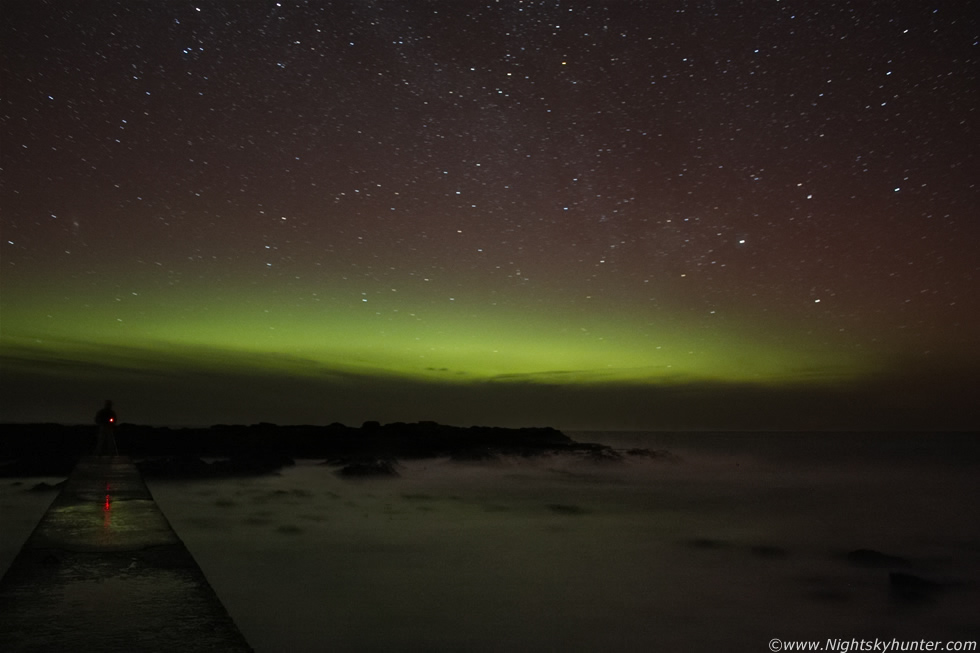

 |
 |
On March 1st 2011 a fast moving solar wind stream impacted Earth causing a G1 geomagnetic storm which hit during daylight hours for all of UK and Ireland. What began as an interesting surge in activity turned into a high alert event when the KP reached a value of 6 with a south tilting Bz component and as a result mid northern latitudes were on amber alert and the charts stayed that way all day long which meant there was an ongoing aurora visible from here however we couldn't see it due to daylight, and so the waiting game began with much time spent on the computer watching the online aurora charts. Conor McDonald and I were swapping phone calls and making plans to catch the aurora on camera and as soon as the first stars appeared at dusk we hit the road and drove towards the north coast of N. Ireland to Co. Antrim which would offer us a perfect view of the aurora over the dark Atlantic Ocean. This wasn't the only reason for the Antrim coastline is a famous location with an abundance of scenic places which could work well in a photo. Our main goal however was to catch the aurora over Dunluce Castle located between Portballintrae and Portrush which would make for a remarkable scene and it was in that direction in which we advanced.
We had spent many nights (and days) 'training' in this area taking long exposures and checking out angles relative to north so it was just a matter of getting there in time before the aurora vanished. During the drive we saw nothing in the sky at all which even hinted at aurora activity due to the light pollution from Coleraine and Portstewart however once we escaped the sodium glare and plunged into the darkness of the Antrim coast we were greeted by a stunning sky with brilliant stars and as our eyes adjusted we could see the aurora with ease stretching across the N to NW skyline. We pulled over at a lay by on the edge of a cliff and got out for our first look at the aurora, at this point it looked like a vivid band extending across the sky with a green hue easily visible to the naked eye, above this where rich star fields while below was the inky blackness of the Atlantic Ocean, and somewhere far below we could make out the sound of waves. A large mass of cloud obscured the lower regions of the aurora in the direction of Scotland however it didn't look to be serious enough to mess with our photo plans so we got back on the road and followed the shore on round until we found the turn for castle.
 |
On location we entered the sloping grass area which lead down to the pitch black outline of the famous Dunluce Castle and above it we saw the green aurora silently doing its thing above the ancient ruins, on occasion a passing car headlight would illuminate the side of the castle revealing its haunting stone work to the eye before being plunged into darkness once again. As this unique and remarkable scene was unfolding I could see countless stars in a perfect black sky above the aurora while far below was the vast shadowy blanket of the creeping ocean which could only be seen with keen dark adaption. This special scene was underscored by the subdued rumbling of the waves crashing against the rocks far below and for a minute or two I just stood there taking in the scene, this was something which I had always wanted to experience and now it was happening for real. From our location we could see lights near the castle, some rectangular and stationary while another, obviously a torch, was sweeping the castle so it was obvious that there where other people there and some of them had cameras. We slowly walked down the slope towards the Castle, one had to take great care as it was pitch black with treacherous ground with a shear drop on either side, as we neared the lights I saw a group of figures and it wasn't long before a voice called out from the night, it was Declan O'Doherty from Maghera, who was busy taking images and with him was my cousin Glen Convery. A third figure with a Canon 5D MkII was also shooting the scene however it was so dark all I could see were tripod legs, black figures, and hear voices. With the introductions over with we got busy shooting the aurora.
The above image shows the very scene I described, this was taken with the 18-55mm kit lens at 18mm, ISO1600, F/3.5 for 84 sec's. I composed the scene is such a way to show the castle, aurora, cliff, and motion of the rolling sea below and by good fortune a passing car lit the right side of the castle turrets making the ruins easier to see in the final image. At this stage the aurora was 100 degrees long and 15 degrees high and was an easy naked eye phenomena. The camera picked up the green band but also detected a red colour which couldn't be seen visually, this red colour is part of the aurora which covered a huge area of sky and, as can be seen above, it filled the entire 18mm frame. If you look carefully you can even see the red reflecting in the sea below, the star fields from L to R are Cygnus, Lyra, Draco, and Hercules. To get the above image I had to climb over a guard rail which prevented the public from getting too close to the cliff edge, the rail itself was getting in my way so I went over it and set-up the tripod on a small wedge of grass literally on top of a cliff in pitch darkness, at the bottom of the image you can just make out the edge, below that is a massive drop onto the rocks below so it was a little unnerving to say the least.
 |
We spent a long time shooting the aurora in proximity to the castle, however the highlight of this period was when the four us where standing near the edge of the cliff looking NW across the dark ocean watching the intense aurora flexing in brilliance before going into a sudden outburst - one of three such events that night. Two areas of intense activity broke out in the far L and R sections of the band when a battery of multiple vertical rays put on a show with slender torch-like beams aiming skyward while waxing and waning in magnitude as they slowly danced horizontally across the green band. This exciting episode began as an isolated bright enhancement which would divide into slim pillars which would then narrow and brighten then drift eastwards along the curved band before fading from view only to be replaced by another set, one of these rays reached 40 degrees high with its apex flirting with the stars of Perseus. This image was at 73 sec's, ISO1600, 18mm, F/3.5 which clearly shows a selection of rays near Vega and slicing through a section of the Keystone of Hercules.
 |
This image had a shutter speed of 59 sec's which produced a better result because the longer shutter of the latter image caused the vertical rays to blur and blend together as they moved. The rays on this image are very well defined with two particularly attractive beams near the wing tip of Cygnus and Hercules with Vega visible between each of them, yet again the aurora was bright enough to turn the sea into a pink-red colour. The atmosphere at this stage was difficult to describe with words or do justice with images, the four of us near the grounds of this famous castle in utter darkness while the aurora put on a show for us across the Atlantic, I wondered how many times the long gone occupants of this castle must have witnessed such a sight and stood there with awe and wondered what it must mean. I took the above two images literally on the edge of a cliff, my tripod leg was only 6 inches from a shear drop into the sea and I was standing only several feet from that same edge, the only thing solid was the wall of the castle to my L, all else around me was air, I can tell you my heart was in my mouth a few times however I'm glad I made the effort because the memory which this image invokes will be something I will never forget.
 |
After several hours had passed we decided to change location, Declan and Glen hit the beach for photos in the White Rocks area while Conor and I drove further along the coast and found a perfect location near a small sheltered harbour. It really was shocking how dark this place was, I mean this was BLACK, the kind of darkness which would show no mercy as one wrong step could result in a sudden plunge into the ocean. We used the lights from our mobile phones and camera LCD screens to navigate which didn't offer much illumination at all. In the darkness we had to walk over a large area of jagged rocks while trying not to fall and break our limbs or cameras. We made it to an elevated position where a long stone jetty extended far out into the sea so Conor and I carefully walked out across the slippery surface and began shooting the aurora.
It was from there where I took the above image, this was 73 sec's showing the sea to the L and R of the jetty with Conor standing at the far end, the aurora was so bright that we could see it's green glow on the sea and on the jetty itself, at one stage I could even see the subtle red colour above the green which had previously been invisible all night. Above Conor you can see the fuzzy glow of M31 with Milky Way and the constellations of Andromeda, Lacerta, Cepheus, and Cygnus. Standing on that narrow jetty in the middle of the night was surreal in the extreme with aurora and periodic big waves which would suddenly loom from the darkness and race towards the jetty and at times splashing over the top, we were very lucky we didn't get washed in. The night ended with Conor and I standing on the shore while waves crashed around us followed by two meteors which zipped down through the aurora as we watched, it was the perfect end to a perfect performance. Without question this was the best aurora display we had observed since 2005, it put on a decent show for many hours and was caused by a simple solar wind stream which made the event even more unusual, however more than that was observing this finest of all sights from the ocean shore and castle which made this a night which I shall never forget. Thanks for reading.
Martin McKenna